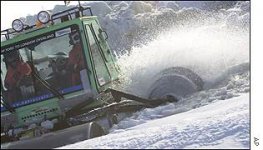Snowcat Operations
Active member
Heres the story. http://news.bbc.co.uk/1/hi/uk/1253733.stm
Two British explorers have been forced to call off their attempt to become the first to cross the Bering Strait from Alaska to Russia in a land vehicle. Steve Brooks and Graham Stratford postponed their expedition until next year after their Snowbird 5 vehicle sustained slight damage during a trial at base camp in Wales, Alaska.
An expedition spokeswoman said the £150,000 custom-built amphibious snowcat lost a hydraulic hose when it hit an ice shelf coming out of the water.

Now we know the awesome and destructive power of the elements we're up against

Steve Brooks
The team had hoped to raise £500,000 for the Just a Drop development charity from the Ice Challenger crossing.
The expedition itself was preparation for a more arduous challenge in 2002 - driving from New York to London by heading west across Alaska and through Russia to Europe.
Snowbird 5 became embedded in the ice as the water froze and had to be cut free using a chainsaw.
'So near, yet so far'
The spokeswoman added: "The team did not have the necessary facilities in Alaska to undertake the repairs and they became worried Snowbird was not strong enough to make the journey.
"A team of British engineers are to make a few adjustments before they make another attempt next year."
Mr Brooks expressed his disappointment as the Snowbird was flown home aboard a Hercules transport.

The challenge has beaten other explorers in the past
"From here in Wales, Alaska, we can see the north east coast of Russia.
"So near, yet so far.
"There is no substitute for experience and now we know the awesome and destructive power of the elements we're up against."
The team had hoped to use the short period each year when the 56-mile strait fills with shifting ice floes to make the crossing from the US to Russia.
The crossing would have been so dangerous the team was preparing to stay awake throughout the six day journey in temperatures which could dip to -60°C.
Polar bears
The challenge has already defeated the likes of British explorer Sir Ranulph Fiennes, and was unthinkable throughout the Cold War.
Mr Brooks, 40, a developer of Chelsea, south west London, and Mr Stratford, 38, of Hereford, Herefordshire, who works with the mountain rescue team in the Brecon Beacons in Powys, Wales, had prepared for the trek for the past three years.

Snowbird 5, which is a cross between a bulldozer and a raft, was billed as the "world's first track and screw vehicle".
It floats on two large cylinders on each side and has a corkscrew thread on which the cylinders can be rotated at 3mph so it can tread through the water and claw back to the surface.
The expedition carried many risks with temperatures dropping to up to minus 70C, winds blowing at speeds of up to 70mph and the ever-present danger of polar bears.
An expedition spokeswoman said the £150,000 custom-built amphibious snowcat lost a hydraulic hose when it hit an ice shelf coming out of the water.

Now we know the awesome and destructive power of the elements we're up against

Steve Brooks
The expedition itself was preparation for a more arduous challenge in 2002 - driving from New York to London by heading west across Alaska and through Russia to Europe.
Snowbird 5 became embedded in the ice as the water froze and had to be cut free using a chainsaw.
'So near, yet so far'
The spokeswoman added: "The team did not have the necessary facilities in Alaska to undertake the repairs and they became worried Snowbird was not strong enough to make the journey.
"A team of British engineers are to make a few adjustments before they make another attempt next year."
Mr Brooks expressed his disappointment as the Snowbird was flown home aboard a Hercules transport.

The challenge has beaten other explorers in the past
"From here in Wales, Alaska, we can see the north east coast of Russia.
"So near, yet so far.
"There is no substitute for experience and now we know the awesome and destructive power of the elements we're up against."
The team had hoped to use the short period each year when the 56-mile strait fills with shifting ice floes to make the crossing from the US to Russia.
The crossing would have been so dangerous the team was preparing to stay awake throughout the six day journey in temperatures which could dip to -60°C.
Polar bears
The challenge has already defeated the likes of British explorer Sir Ranulph Fiennes, and was unthinkable throughout the Cold War.
Mr Brooks, 40, a developer of Chelsea, south west London, and Mr Stratford, 38, of Hereford, Herefordshire, who works with the mountain rescue team in the Brecon Beacons in Powys, Wales, had prepared for the trek for the past three years.

Snowbird 5, which is a cross between a bulldozer and a raft, was billed as the "world's first track and screw vehicle".
It floats on two large cylinders on each side and has a corkscrew thread on which the cylinders can be rotated at 3mph so it can tread through the water and claw back to the surface.
The expedition carried many risks with temperatures dropping to up to minus 70C, winds blowing at speeds of up to 70mph and the ever-present danger of polar bears.


 They would have made it had the awesome power of a VW engine neatly tucked backwards into the front of a Snow Trac!
They would have made it had the awesome power of a VW engine neatly tucked backwards into the front of a Snow Trac! 